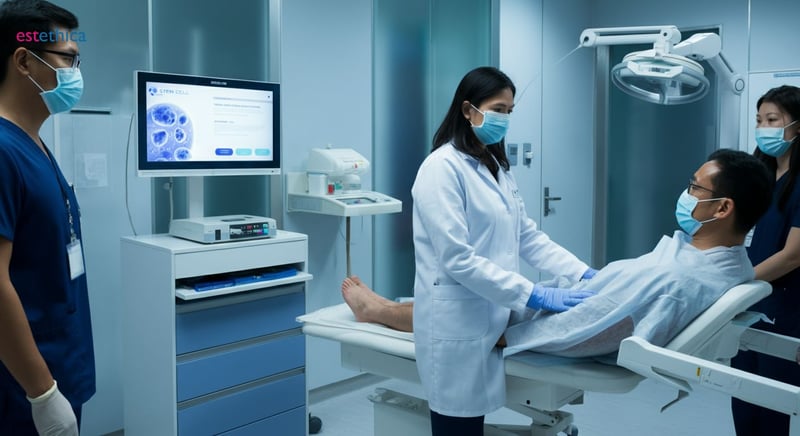Unlocking the Secrets of Stem Cell Therapy in Cosmetic Dermatology
Explore the future of skin health with stem cell therapy innovations.
Stem cell therapy is rapidly becoming a cornerstone in the world of dermatology, offering innovative solutions for a myriad of skin conditions. This revolutionary approach hinges on the potential of stem cells to regenerate and repair damaged tissues, bringing hope to individuals seeking natural and effective skin rejuvenation. In recent years, research in stem cell applications for dermatology has escalated, showcasing promising outcomes in combating aging, healing scars, and treating skin diseases.
The intrigue surrounding stem cells lies in their unique ability to morph into various cell types, making them an invaluable resource in regenerative medicine. As we delve into the world of stem cell therapy, it is essential to understand how these cells function, the multitude of benefits they offer, and the latest advancements in this field. Whether you're grappling with conditions like acne scars or exploring preventative skincare, stem cell treatments represent the frontier of dermatological care.
Understanding How Stem Cell Therapy Works for Skin Health
Key Benefits of Stem Cell Therapy for Skin Health
- Enhances skin elasticity, leading to a more youthful appearance.
- Improves skin tone and texture, providing a smoother surface.
- Promotes natural healing, reducing the appearance of scars and blemishes.
Stem cell therapy offers a range of benefits for skin health, primarily by utilizing the regenerative capabilities of mesenchymal stem cells (MSCs). These cells can transform into various skin cell types, aiding in the repair and rejuvenation of damaged skin. For instance, individuals with acne scars have reported noticeable improvements in skin texture and tone after undergoing stem cell treatment. Moreover, the therapy's ability to enhance skin elasticity can significantly reduce the signs of aging, such as wrinkles and fine lines.
Process of Stem Cell Therapy for Skin Rejuvenation
- Extraction of stem cells from fatty tissue or bone marrow.
- Isolation and manipulation of stem cells to enhance their regenerative properties.
- Introduction of stem cells to targeted skin areas to stimulate repair.
The process of stem cell therapy for skin rejuvenation involves several critical steps. Initially, stem cells are extracted from sources like fatty tissue or bone marrow. These cells are then isolated and manipulated in a laboratory setting to enhance their regenerative properties. Finally, the prepared stem cells are introduced to the targeted skin areas, where they facilitate natural healing processes. This method has shown promising results in improving skin health, with patients experiencing reduced skin imperfections and a more even complexion.

Exploring the Benefits of Stem Cell Treatments in Dermatology
Innovative Advantages of Stem Cell Therapy in Dermatology
- Reduces inflammation, providing relief for conditions like eczema and psoriasis.
- Accelerates wound healing, minimizing scarring and promoting tissue regeneration.
- Enhances collagen production, leading to firmer and more resilient skin.
Stem cell therapy in dermatology offers innovative advantages by leveraging the body's natural healing processes. For example, patients with chronic skin conditions such as eczema and psoriasis have experienced significant relief due to the therapy's anti-inflammatory properties. Additionally, the accelerated healing of wounds reduces the risk of scarring, which is particularly beneficial for individuals recovering from surgeries or injuries. The therapy's ability to boost collagen production is another key advantage, as it helps improve skin firmness and resilience, combating the effects of aging.
Mechanisms Behind Stem Cell Therapy's Dermatological Benefits
- Activation of dormant skin cells to enhance repair and regeneration.
- Stimulation of new blood vessel formation to improve skin nourishment.
- Modulation of immune responses to reduce chronic inflammation.
The mechanisms behind stem cell therapy's dermatological benefits are multifaceted. Initially, the therapy activates dormant skin cells, enhancing their ability to repair and regenerate damaged tissues. This activation is crucial for improving skin health and appearance. Furthermore, stem cell therapy stimulates the formation of new blood vessels, which enhances skin nourishment and vitality. Finally, by modulating immune responses, the therapy effectively reduces chronic inflammation, offering relief for various inflammatory skin conditions. These mechanisms collectively contribute to the profound benefits observed in dermatological applications of stem cell therapy.

Latest Advances in Stem Cell Research for Skin Conditions
Innovations in Stem Cell Bioengineering
Recent advancements in stem cell research have significantly enhanced the potential applications of this therapy in dermatology. One of the most promising innovations is the bioengineering of stem cells to improve their efficacy and safety. By tailoring treatments to individual patient needs, researchers can now create more personalized and effective therapies. For instance, bioengineered stem cells can be programmed to target specific skin conditions, such as psoriasis, by correcting cellular dysfunction at its root. This approach not only increases the success rate of treatments but also minimizes potential side effects.
Emerging Technologies in Stem Cell Therapy
- 3D bioprinting enables precise delivery of stem cells to affected areas.
- Induced pluripotent stem cells (iPSCs) offer a versatile source for therapy.
- Advanced imaging techniques improve monitoring of treatment progress.
Emerging technologies are playing a crucial role in advancing stem cell therapy for skin conditions. 3D bioprinting, for example, allows for the precise delivery of stem cells to targeted areas, enhancing the accuracy and effectiveness of treatments. Additionally, the use of induced pluripotent stem cells (iPSCs) provides a versatile and ethically favorable source for therapy, as these cells can be derived from a patient's own tissues. Advanced imaging techniques further complement these innovations by enabling real-time monitoring of treatment progress, ensuring optimal outcomes for patients.
- Identification of patient-specific cellular dysfunctions.
- Customization of stem cell treatments to address these dysfunctions.
- Application of bioengineered cells to restore normal skin function.
These advancements in stem cell research are paving the way for more targeted therapy options. By identifying patient-specific cellular dysfunctions, researchers can customize stem cell treatments to address these issues directly. The application of bioengineered cells then works to restore normal skin function, offering hope for individuals suffering from chronic skin conditions like eczema and vitiligo. This personalized approach not only enhances treatment efficacy but also represents a significant step forward in regenerative medicine.

Finding the Best Stem Cell Clinics for Dermatological Care
Evaluating Clinic Expertise and Patient Care
When searching for the best stem cell clinics for dermatological care, it's essential to evaluate the expertise of the medical staff and the level of patient care provided. Clinics in locations like New York and California are renowned for their advanced stem cell treatment facilities, offering innovative therapies with impressive patient success rates. For example, a clinic in New York might specialize in using stem cell therapy to treat chronic skin conditions, while a California clinic could focus on cosmetic applications, such as anti-aging treatments. These clinics often employ leading dermatologists and researchers who are at the forefront of stem cell research, ensuring that patients receive cutting-edge care tailored to their specific needs.
Key Considerations for Choosing a Stem Cell Clinic
- Verify the clinic's accreditation and certifications.
- Assess the range of stem cell therapies offered.
- Consider patient testimonials and success stories.
Choosing the right clinic involves several key considerations. First, verify the clinic's accreditation and certifications to ensure compliance with medical standards. Next, assess the range of stem cell therapies offered, as some clinics may provide specialized treatments for specific skin conditions. Additionally, consider patient testimonials and success stories to gauge the clinic's track record. For instance, a clinic with numerous positive reviews for its stem cell therapy for acne scars might be a suitable choice for individuals seeking similar treatments.
- Research the clinic's history and reputation in stem cell treatments.
- Consult with the clinic's specialists to understand their approach.
- Evaluate the clinic's use of the latest technologies and techniques.
Researching the clinic's history and reputation in stem cell treatments is crucial for making an informed decision. Consulting with the clinic's specialists can provide insights into their approach and how it aligns with your treatment goals. Finally, evaluate the clinic's use of the latest technologies and techniques, as these can significantly impact the effectiveness and safety of the treatments offered. By considering these factors, you can select a clinic that not only meets your needs but also provides the highest standard of care in stem cell dermatological treatments.
Innovative Stem Cell Bioengineering Techniques
Excellence in Stem Cell Therapy for Skin Rejuvenation
Frequently Asked Questions
What is stem cell therapy and how does it work for skin health?
What are the benefits of stem cell treatment in dermatology?
What are the latest advances in stem cell research for skin conditions?
Is stem cell treatment safe for dermatological applications?
How can I find the best stem cell clinics for dermatological care?
Discover the art of healthy beauty with estethica's award-winning services. Call now for your free consultation and take the first step towards a more confident you!
📞 Call for Your Free Consultation